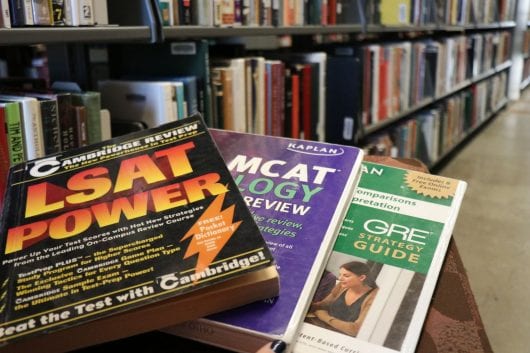
The LSAT, MCAT and GRE are popular standardized tests used for graduate school admissions. Credit: Casey Cascaldo | Photo Editor
On top of living expenses, tuition and everyday expenditures, students interested in pursuing graduate school have to consider not only the cost of applying to programs, but the cost of exam preparation.
The GRE graduate school entry exam, the LSAT law school aptitude test and the MCAT medical school exam are three common exams undergraduate students take in pursuing graduate programs.
The GRE is required for most graduate programs, from master’s in humanities fields to doctorates in STEM fields and according to its website costs $205. In 2017, 77 percent of students taking the test were under 25 years old and 44 percent of takers were under 23.
“I got one of those Kaplan study guide books with an online access code, and I think overall that cost me a few hundred dollars,” said Collin Roberts, Ohio State alumnus and current material science and engineering Ph.D. student at UCLA. “I got the practice guide and studied basically every day for an hour or two.”
Andrea Thompson, an Ohio State fourth-year in psychology currently applying to clinical psychology doctoral and social work programs, said she has found more affordable alternatives to some of the more expensive study guides for graduate exams. She said she uses materials like preparation guidebooks and tools found on the internet to help study.
“I use online questions of the day a lot and use Quizlet for math equations and vocab words I don’t know,” Thompson said.
The MCAT costs $315, which is a small amount compared to the cost of in-person test prep, which can cost more than $2,000.
“I did the Kaplan prep course and Ohio State always has both Kaplan and Princeton Review prep courses come and talk to students,” said Christy Sharrer, Ohio State alumna and current special master’s in physiology student at the University of Cincinnati.
Sharrer said even though the in-person prep can be more expensive, it allows students to study until the day of the test compared to cheaper, online options that only offer a couple of practice tests and no in-person assistance.
Students looking to take the MCAT also must consider the application cost in addition to preparation.
“I saved for a couple years, but when it came down to applying, I wasn’t as fortunate as people that had their parents helping out,” Sharrer said. “So I could only apply to 15 schools and some of my friends applied to 36 schools.”
From 2014-18, the average age of medical school applicants was 24 years old, according to the Association of American Medical Colleges.
The LSAT costs $190, and in 2015, half of all law school applicants were between the ages of 22 and 24, according to the Law School Admissions Council.
“I started [preparing] by looking at reviews for the best LSAT prep books online and then bought all the ones I have off of Amazon,” said Lila Appaya, a fourth-year in psychology on a pre-law track. “Powerscore’s ‘Logical Reasoning Bible’ was definitely the best, most helpful book I got.”
Appaya also credited Ohio State with giving her opportunities to help her prepare.
“OSU offered this free LSAT my sophomore year because they were trying out a digital LSAT and that helped me get a feel for it,” Appaya said. “Also, I’m in a pre-law fraternity at OSU called Phi Alpha Delta and that was super beneficial because they always bring people in for free LSAT prep courses from companies like Powerscore.”
Appaya said she took additional steps toward preparing for the LSAT and noted the competitive prices between preparation companies.
“I decided at the end of the summer to get tutoring for [the LSAT] from this place called 7sage, which sells online classes and materials for a lot less than Powerscore and Kaplan,” Appaya said.
Powerscore and Kaplan online classes both cost around $1,100 and $1,300.
For undergraduate students looking to pursue a graduate degree, Ohio State’s Career Counseling and Support Services located in the Younkin Success Center offers a variety of resources to explore graduate programs and financial aid opportunities.


